萧伯纳经典戏剧ygmalion卖花女课件
- 格式:ppt
- 大小:1.58 MB
- 文档页数:33
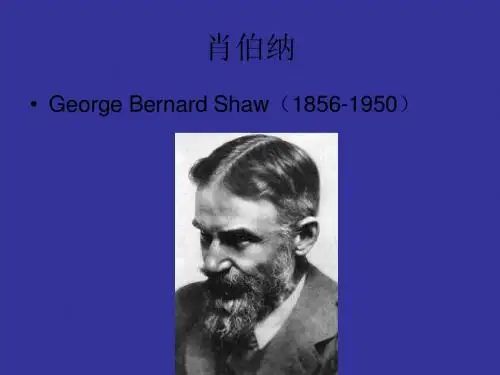

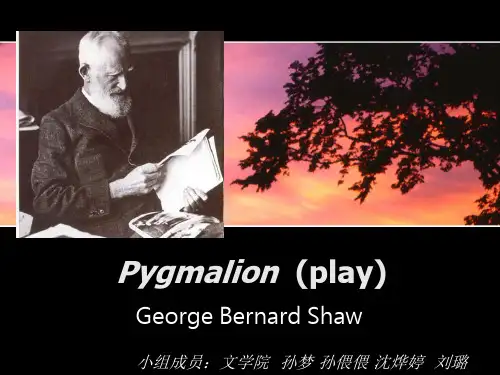
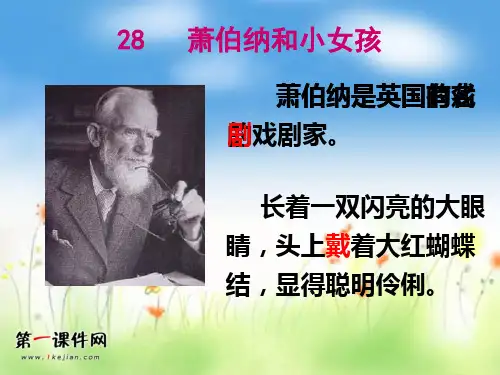




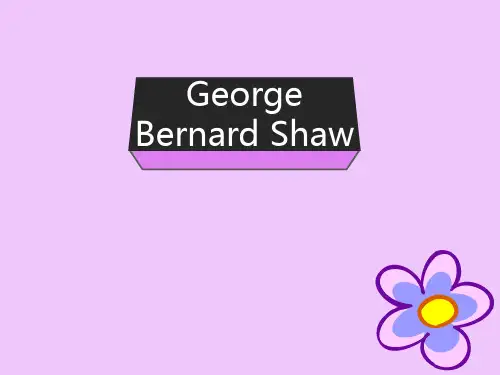

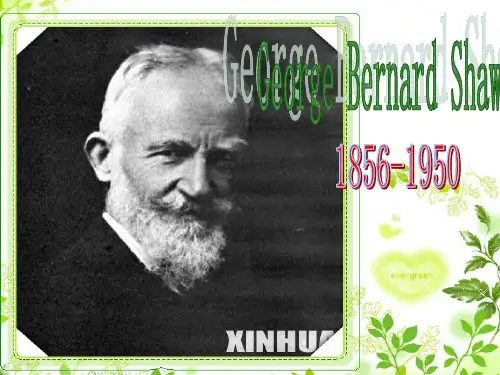
Unit 4 PygmalionI 教学内容分析本单元的中心话题是萧伯纳的名剧《卖花女》。
主题是通过分析剧中的人物的性格展开的,各项语言活动都是围绕剧情和作者萧伯纳来设计的。
Warming up部分展现了关于希腊神话《皮格马利翁》的三幅图片,使学生对《卖花女》的由来有一个初步印象;通过对每个问题的讨论为进一步学习做准备。
Pre-reading部分设计的三个问题是逐层展开的,第一个问题借助电影My Fair Lady让学生了解Pygmalion。
第二、三题通过讨论、思考等形式充分调动学生积极性,发挥想象力,为阅读和理解做准备。
Reading是剧本中第一场,描述流落街头言行粗俗的卖花女Eliza偶遇来自上层社会的语言学专家希金斯教授和皮克林上校,通过双方的对话及代表性语言突出了本剧的主题,人可能通过后天努力改变现状。
鼓励学生挖掘自我潜力,勇于超越自我。
Comprehending部分针对文章内容设计了五个练习,旨在加强学生对文章内容和主题的理解及语言规范化训练。
Learning about Language部分是剧本中的第二场,由于与皮克林上校打赌希金斯教授勉强收下上门求学以期改变命运的Eliza。
本部分包括听、说、谈、写四部分内容。
Learning Tip指导学生阅读名著改编的小说和剧本,扩大课外阅读量,有效地提高英语水平,并尝试读、演话剧,改进语音、语调。
II. 教学重点和难点1、教学重点(1)本单元的生词和短语及其用法;(2)复习掌握过去分词作状语的用法;(3)了解Pygmalion的剧情,理解“皮格马利翁效应”。
2、教学难点(1)了解萧伯纳的生平及作品特点;(2)初步学会一些对人或事物进行猜测,判断和评价的常用句式。
III. 教学计划本单元建议分六课时第一课时:Warming Up, Listening (Workbook) & Talking (Workbook)第二课时:Pre-reading, Reading & Comprehending第三课时:Learning about Language第四课时:Reading (Using Language) & Reading task (Workbook)第五、六课时:Listening and speaking (Using Language), Listening task (Workbook), Speaking and writing (Using Language) & Speaking task (Workbook)IV. 教学步骤Period 1. Warming Up, Listening (Workbook) & Talking (Workbook) Teaching Goals:1. To arouse Ss’ interest in knowing the content of the whole story.2. To develop Ss’ sp eaking ability.Purpose: To activate Ss and arouse them to say something about the famous actress.Show the pictures about the famous actress. Ask Ss if they know her and what they know about My Fair Lady.Step 2. Warming UpPurpose: To lead the Ss to the theme of this unit.1. Tell Ss the film My Fair Lady or Bernard Shaw’s play Pygmalion is an adaptation of a Greek story. Ask Ss to look at the pictures on P28 and tell the story to their partners.2. Divide the whole class into groups of four to discuss the three questions of Warming up on P28. Encourage them to speculate about whether they think Pygmalion and his wife will have problems once they do get married. Here are some more questions in detail.(1) Does the statue-wife have any ideas of her own?(2) Will Pygmalion allow his wife to be an independent person?(3)Will they lead a happy life after marriage?(4) Will they have any problems?(5) Who will have to change more to solve the problems?Ask some students to report. All these questions have no right or wrong answers.3. Ask Ss to discuss the following questions, encouraging them to imagine the details. Ask someindividuals to give their answers and reasons.Question 1. Did Pygmalion work hard when he made the statue?Question 2. How could the statue come into life?Question 3. Why did the Greek Goddess grant his wish?Conclusion:If someone wants to get something very much, he/she just try his/her best. Nothing is impossible.Step 3. Pre-listeningPurpose: To help Ss learn about the context of the Listening text.1. Ask Ss to discuss in groups of four according to the picture on P29.(1) Who are the two persons in the picture?(2) What do you know about them?(3) How will they judge whether Eliza is a lady or not?2. After discussing, ask some Ss to present their opinions to the whole class.Step 4. Listening (Workbook)Purpose:To develop the Ss’ listening ability.To know some characters about the main roles in the play.1. Ask Ss to listen to the tape and finish Ex1 on P70.2. Ask Ss to listen to the tape once again and finish Ex3 on P70.3. Allow Ss several minutes to discuss the answers to Ex4 on P70 and call out several Ss to read aloud their answers to check with the whole class.Step 5. Talking (Workbook)Purpose: To get Ss to make up the conversation.1. Ask Ss to discuss the questions below. Allow Ss several minutes to exchange their ideas.(1)What is your opinion about Pickering, Henry and Eliza’s characters?(2)How did Eliza perform?(3)What do Pickering and Henry want to say to her?2. Ask Ss to go through the expressions given in the exercise. Remind them to express the exact idea politely.3. Ask Ss to follow the following steps to finish their dialogues.(1) In pairs, Ss work on the speech that Pickering and Henry will make to Eliza, then practicethe conversation together.(2) Ask Ss to perform their conversation to another pair and give advice to each other.(3) Allow Ss several minutes to get prepared. Ask some pairs to present their dialogues.Step 6. Homework1. Ask Ss to continue practicing their conversation.2. Ask Ss to find some more information about Bernard Shaw and his play.Period 2 Pre- reading, Reading & ComprehendingTeaching Goals:1. To learn about the content of Act One of the play.2. To deve lop Ss’ some basic reading skills3. To arouse Ss’ interest in appreciating literature.Teaching Procedures:Step 1. Pre-readingPurpose: To arouse Ss’ interest in learning about the play.1. Show some pictures from My Fair Lady. Ask Ss to answer the following questions.(1) Have you ever seen the film?(2) Do you like it? Why?(3) What is the theme of it?2. Ask Ss to go through the information on the main characters below and try to match themain characters in the play and in the Greek story.(1) Pygmalion A. Pickering(2) Statue B. Higgins(3) Greek God C. ElizaSuggested Answers: (1) B (2) C (3) AStep 2. Fast readingPurpose: To get a brief understanding of Act One.1. Ask Ss if they are curious about the plot in the play and then give them some time to read the text. While reading, Ask them try to find out the information as quickly as possible2. Ask Ss to read the text quickly and work in pairs to finish Ex1 and Ex2 of Comprehending on P30~P31.3. Divide the whole class into boys group and girls group. Allow them some time and see which group can finish Ex4 on P30 correctly first. Check the answer with the whole class.4. Ask Ss to discuss in groups of four: What other things show one’s status in so ciety apart from how one speaks? Call out some Ss to report. Write down the points on the Bb.clothes you wearexpensive possessions (like cars or jewellery)attitudes and behavioureducation levelhow many foreign languages spoken and countries visitedStep 3. Intensive readingPurpose: To get Ss to have some more details in the text.1. Ask Ss to read the text carefully and try to get more details from the text and then find out the answers to these “why” questions.(1)Why can we say that Eliza must be in a lower class?(2)Why was Higgins respectful to Pickering?(3)Why did Pickering and Higgins feel so happy when they met each other ?(4)Why did Eliza want to find Higgins the next day ?Suggested Answers:(1)Her language and behaviour(2)In his opinion ,Pickering is an equal and friend.(3)Both of them were interested in phonetics and they were looking for each other.(4)She wanted to change her life very much and she believed what Higgins said.2. Ask Ss to try their best to remember the information of the play according to the picture. Then Ask Ss to listen to the tape and try to follow in a low voice.3. Ask the Ss to retell the story according to the picture above, call out several Ss to do it to the whole class.4. Still divide the class into boys and girls group.Give them some time to do Ex 5 on P31. See which group can finish first.Step 4. Homework1. Ask Ss to write a short passage to introduce the story briefly.2. Ask Ss to go over Act One and try to find out the language points3. Ask Ss to finish Ex1 and Ex2 of Discovering Useful Words And Expressions on P32.Period 3. Learning about LanguageTeaching Goals:1. To enable Ss to master some new words and expressions.2. To get Ss to have knowledge of the grammar point: past participles used as adverbial. Teaching Procedures:Step 1. Warming upPurpose: To go over the words and phrases in the text.Call out some Ss to check the answers to Ex1 and Ex2 of Discovering Useful Words And Expressions on P32.Step 2. Word studyPurpose: 1. To enable Ss to master some new words and expressions.2. To encourage Ss to use the words in sentences.1. Allow Ss some time to finish Ex1 and Ex2 of Using Words And Expressions on P71. Call out some Ss to check the answers.2. Tell Ss that words can show approval or disapproval. Let Ss try to finish Ex3 of Using Words And Expressions on P72 in pairs. Ask them to discuss about the difference of the words.3. Divide the whole class into boys and girls group and try to see which group can finish the sentences in Ex4 on P72 first.Step 3 Language point.Purpose: To train Ss’ language capacity1.Call out some Ss to list their difficult words and phrases, write them down and give necessaryexplanations.(1)while watching, he makes notes.(2)… hands over the paper covered with writing.(3)There you are and you come from the west end of London, born in Lisson Grove if I’m notmistaken.(4)What if I was?(5)But they betray themselves every time they open their mouths.(6)Once educated to speak properly, the girl could pass herself off as a duchess at anambassador’s garden party.Step 4. GrammarPurpose: To get Ss to have knowledge of the grammar1. Ask Ss to finish Ex1, Ex2 and Ex3 of Revising useful structures on P33. Check the answer together with the whole class orally.2. Explain for Ss the grammar point.(1) 过去分词作状语时逻辑主语与句子主语一致,即句子主语是过去分词动作承受者。